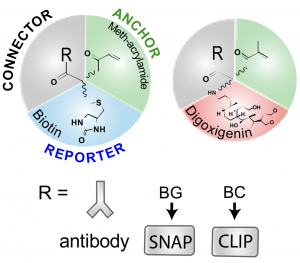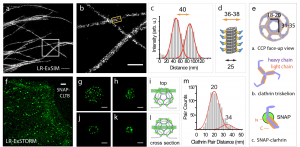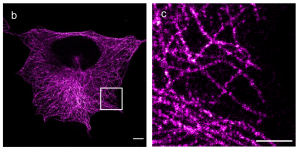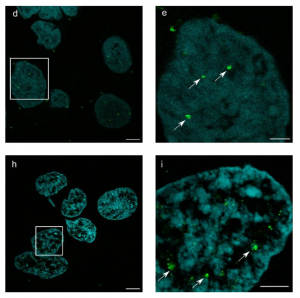Label-retention expansion microscopy
Preprint posted on 2 July 2019 https://www.biorxiv.org/content/10.1101/687954v2
Article now published in Journal of Cell Biology at http://dx.doi.org/10.1083/jcb.202105067
Evaluation of direct grafting strategies in Expansion Microscopy
Preprint posted on 8 July 2019 https://www.biorxiv.org/content/10.1101/696039v1
What if we could see every single epitope of interest in a sample? Two recent studies independently show that trifunctional anchors can improve dramatically the retention of labels in expansion microscopy.
Selected by Romain F. LaineCategories: biochemistry, bioengineering, molecular biology
Context
Since the seminal work from the group of Ed Boyden in 2015 [1], expansion microscopy (ExM) has literally turned the idea of resolution limit in microscopy upside down. While the field of super-resolution microscopy is trying to use optical methods to break the diffraction barrier of microscopy, Boyden asked: what if we expanded the sample instead? This is possible by first embedding the sample with polyelectrolytes that polymerise to form a hydrogel throughout the sample. This gel has an extremely fine mesh size of only a few nanometers, which allow the trapping of the molecules of interest in place. Importantly, this gel can also be expanded by osmotic pressure when the sample is subsequently flooded with water.
There are however two main difficulties to do this:
(1) making sure that the expansion is uniform in all direction and in all locations of the sample
and (2) retaining the capacity to specifically visualise the molecules of interest.
The first issue is commonly addressed by using detergent or enzymatic digestion to ensure that the mechanical properties of the sample is uniform throughout prior to the swelling step. So, the developments of ExM in the past few years have focussed on designing anchoring systems that can preserved the molecules of interest itself or a proxy for it (such as an antibody against a protein of interest) throughout the different stages of ExM [2,3]. These approaches have proven successful for a range of molecules of interest (e.g. proteins and RNA), cell types and tissue types.
The method promises the prospect of observing bio-molecular assemblies in situ in cells at the nanoscale, especially when combined with optical super-resolution microscopy methods [4]. However, to achieve this, it requires a robust visualisation of every single molecule of interest within the assembly, and this is currently limited by losses of labels and/or fluorescence during the polymerisation and digestion stages of ExM.
Key findings
Both Shi et al. (from the Huang lab at UCSL) and Wen et al. (from the Hofkens lab at KULeuven) concommitently address one of the main hurdle of ExM: the fact that many labels and much of the fluorescence can be lost in conventional ExM protocols. For this, the teams independently developed a set of trifunctional anchors that are capable of binding to the molecule of interest (1), to the hydrogel (2) and to the fluorescent reporter (3) simultaneously. Importantly, these anchors can also sustain the process of digestion necessary for ExM, therefore retaining a high number of labels and fluorescence molecules available for the post-expansion imaging.
In the method from Shi et al. (called LR-ExM, for label-retention ExM), two orthogonal labelling methods were shown using either biotin/streptavidin or digoxigenin (DIG)/anti-DIG reporter systems in order to add the fluorescent molecules after the expansion step. This avoids the issue of loss of fluorescence signal. The connector to the molecule of interest was demonstrated with either antibodies, SNAP or CLIP tags.

Here, the authors show that their method is compatible with super-resolution microscopy methods such as SIM and dSTORM, the latter showing resolution down to ~12 nm (~5 nm localisation precision). These approaches allow for the direct observation the hollow structure of microtubules, the relative nanoscale organisation of nuclear proteins (LaminA and nuclear pore complex) and, impressively, the lattices from clathrin-coated pits.

On the other hand, Wen et al. developed a large palette of chemistry for this trifunctional approach and showed that it works by conjugating phalloidin for actin labelling, antibody against alpha-tubulin for microtubule visualisation and DSPE for cellular phospholipid membranes labelling. Their approach here focusses on single-step fluorescent labelling prior to expansion where the choice of fluorescent dye is optimised to sustain the process.
Secondly they then extend the approach to DNA oligo labelling, either for fluorescent labelling of the anchor post-expansion or for in situ labelling of mRNA transcripts (similar to FISH), compatible with further signal amplification such as RollFISH and HCR. They therefore show an impressive versatility of chemistry and capabilities.


What I like about these works
These works elegantly and robustly provide a method that allows for direct in-situ observation of bio-cellular structures at the molecular level. This actually bridges with the observation obtained by (cryo-)electron microscopy and fills a gap in molecular observation. Also, this work shows that ExM is gaining maturity and promises to become widely available and robust. This will in turn enable life scientist and labs from all disciplines to study molecular life at unprecedented scale.
Questions to the authors?
Currently, the methods shows trifunctional anchors for 2 individual colours simultaneously. Are there ways to expand the palette to more orthogonal channels? Can both of these methods be combined to expand the capabilities for multi-colour imaging?
With this approach, the direct anchoring to the mesh and molecule of interest allows to get the fluorescent label very close to the molecule of interest? What approaches will give you the smallest effective linker error?
This method will have the highest impact to biomedical research if it is made available on a large scale such as via commercialisation. Is this an avenue that would be explored?
References
[1] F. Chen, P. W. Tillberg, and E. S. Boyden, “Expansion microscopy,” Science (80-. )., vol. 347, no. 6221, pp. 543–548, Jan. 2015.
[2] P. W. Tillberg, F. Chen, K. D. Piatkevich, Y. Zhao, C.-C. J. Yu, B. P. English, L. Gao, A. Martorell, H.-J. Suk, F. Yoshida, E. M. DeGennaro, D. H. Roossien, G. Gong, U. Seneviratne, S. R. Tannenbaum, R. Desimone, D. Cai, and E. S. Boyden, “Protein-retention expansion microscopy of cells and tissues labeled using standard fluorescent proteins and antibodies,” Nat. Biotechnol., vol. 34, no. 9, pp. 987–992, Jul. 2016.
[3] T. J. Chozinski, A. R. Halpern, H. Okawa, H.-J. Kim, G. J. Tremel, R. O. L. Wong, and J. C. Vaughan, “Expansion microscopy with conventional antibodies and fluorescent proteins.,” Nat. Methods, vol. 13, no. April, pp. 1–7, 2016.
[4] D. Gambarotto, F. U. Zwettler, M. Le Guennec, M. Schmidt-Cernohorska, D. Fortun, S. Borgers, J. Heine, J.-G. Schloetel, M. Reuss, M. Unser, E. S. Boyden, M. Sauer, V. Hamel, and P. Guichard, “Imaging cellular ultrastructures using expansion microscopy (U-ExM),” Nat. Methods, vol. 16, no. January, p. 1, 2018.
Posted on: 6 August 2019
Have your say
Sign up to customise the site to your preferences and to receive alerts
Register hereAlso in the biochemistry category:
Structural basis of respiratory complexes adaptation to cold temperatures
Lens Placode Modulates Extracellular Matrix Formation During Early Eye Development
Generalized Biomolecular Modeling and Design with RoseTTAFold All-Atom
Also in the bioengineering category:
Scalable and efficient generation of mouse primordial germ cell-like cells
Multi-pass, single-molecule nanopore reading of long protein strands with single-amino acid sensitivity
Discovery and Validation of Context-Dependent Synthetic Mammalian Promoters
Also in the molecular biology category:
Clusters of lineage-specific genes are anchored by ZNF274 in repressive perinucleolar compartments
Nanos2+ cells give rise to germline and somatic lineages in the sea anemone Nematostella vectensis
Plant plasmodesmata bridges form through ER-driven incomplete cytokinesis
AND
Plasmodesmata act as unconventional membrane contact sites regulating inter-cellular molecular exchange in plants
preLists in the biochemistry category:
BSCB-Biochemical Society 2024 Cell Migration meeting
This preList features preprints that were discussed and presented during the BSCB-Biochemical Society 2024 Cell Migration meeting in Birmingham, UK in April 2024. Kindly put together by Sara Morais da Silva, Reviews Editor at Journal of Cell Science.
| List by | Reinier Prosee |
Preprint Peer Review – Biochemistry Course at UFRJ, Brazil
Communication of scientific knowledge has changed dramatically in recent decades and the public perception of scientific discoveries depends on the peer review process of articles published in scientific journals. Preprints are key vehicles for the dissemination of scientific discoveries, but they are still not properly recognized by the scientific community since peer review is very limited. On the other hand, peer review is very heterogeneous and a fundamental aspect to improve it is to train young scientists on how to think critically and how to evaluate scientific knowledge in a professional way. Thus, this course aims to: i) train students on how to perform peer review of scientific manuscripts in a professional manner; ii) develop students' critical thinking; iii) contribute to the appreciation of preprints as important vehicles for the dissemination of scientific knowledge without restrictions; iv) contribute to the development of students' curricula, as their opinions will be published and indexed on the preLights platform. The evaluations will be based on qualitative analyses of the oral presentations of preprints in the field of biochemistry deposited in the bioRxiv server, of the critical reports written by the students, as well as of the participation of the students during the preprints discussions.
| List by | Marcus Oliveira |
CellBio 2022 – An ASCB/EMBO Meeting
This preLists features preprints that were discussed and presented during the CellBio 2022 meeting in Washington, DC in December 2022.
| List by | Nadja Hümpfer et al. |
20th “Genetics Workshops in Hungary”, Szeged (25th, September)
In this annual conference, Hungarian geneticists, biochemists and biotechnologists presented their works. Link: http://group.szbk.u-szeged.hu/minikonf/archive/prg2021.pdf
| List by | Nándor Lipták |
Fibroblasts
The advances in fibroblast biology preList explores the recent discoveries and preprints of the fibroblast world. Get ready to immerse yourself with this list created for fibroblasts aficionados and lovers, and beyond. Here, my goal is to include preprints of fibroblast biology, heterogeneity, fate, extracellular matrix, behavior, topography, single-cell atlases, spatial transcriptomics, and their matrix!
| List by | Osvaldo Contreras |
ASCB EMBO Annual Meeting 2019
A collection of preprints presented at the 2019 ASCB EMBO Meeting in Washington, DC (December 7-11)
| List by | Madhuja Samaddar et al. |
EMBL Seeing is Believing – Imaging the Molecular Processes of Life
Preprints discussed at the 2019 edition of Seeing is Believing, at EMBL Heidelberg from the 9th-12th October 2019
| List by | Dey Lab |
Cellular metabolism
A curated list of preprints related to cellular metabolism at Biorxiv by Pablo Ranea Robles from the Prelights community. Special interest on lipid metabolism, peroxisomes and mitochondria.
| List by | Pablo Ranea Robles |
MitoList
This list of preprints is focused on work expanding our knowledge on mitochondria in any organism, tissue or cell type, from the normal biology to the pathology.
| List by | Sandra Franco Iborra |
Also in the bioengineering category:
CSHL 87th Symposium: Stem Cells
Preprints mentioned by speakers at the #CSHLsymp23
| List by | Alex Eve |
EMBL Synthetic Morphogenesis: From Gene Circuits to Tissue Architecture (2021)
A list of preprints mentioned at the #EESmorphoG virtual meeting in 2021.
| List by | Alex Eve |
3D Gastruloids
A curated list of preprints related to Gastruloids (in vitro models of early development obtained by 3D aggregation of embryonic cells). Updated until July 2021.
| List by | Paul Gerald L. Sanchez and Stefano Vianello |
ASCB EMBO Annual Meeting 2019
A collection of preprints presented at the 2019 ASCB EMBO Meeting in Washington, DC (December 7-11)
| List by | Madhuja Samaddar et al. |
EMBL Seeing is Believing – Imaging the Molecular Processes of Life
Preprints discussed at the 2019 edition of Seeing is Believing, at EMBL Heidelberg from the 9th-12th October 2019
| List by | Dey Lab |
Lung Disease and Regeneration
This preprint list compiles highlights from the field of lung biology.
| List by | Rob Hynds |
Advances in microscopy
This preList highlights exciting unpublished preprint articles describing advances in microscopy with a focus on light-sheet microscopy.
| List by | Stephan Daetwyler |
Also in the molecular biology category:
BSCB-Biochemical Society 2024 Cell Migration meeting
This preList features preprints that were discussed and presented during the BSCB-Biochemical Society 2024 Cell Migration meeting in Birmingham, UK in April 2024. Kindly put together by Sara Morais da Silva, Reviews Editor at Journal of Cell Science.
| List by | Reinier Prosee |
‘In preprints’ from Development 2022-2023
A list of the preprints featured in Development's 'In preprints' articles between 2022-2023
| List by | Alex Eve, Katherine Brown |
CSHL 87th Symposium: Stem Cells
Preprints mentioned by speakers at the #CSHLsymp23
| List by | Alex Eve |
9th International Symposium on the Biology of Vertebrate Sex Determination
This preList contains preprints discussed during the 9th International Symposium on the Biology of Vertebrate Sex Determination. This conference was held in Kona, Hawaii from April 17th to 21st 2023.
| List by | Martin Estermann |
Alumni picks – preLights 5th Birthday
This preList contains preprints that were picked and highlighted by preLights Alumni - an initiative that was set up to mark preLights 5th birthday. More entries will follow throughout February and March 2023.
| List by | Sergio Menchero et al. |
CellBio 2022 – An ASCB/EMBO Meeting
This preLists features preprints that were discussed and presented during the CellBio 2022 meeting in Washington, DC in December 2022.
| List by | Nadja Hümpfer et al. |
EMBL Synthetic Morphogenesis: From Gene Circuits to Tissue Architecture (2021)
A list of preprints mentioned at the #EESmorphoG virtual meeting in 2021.
| List by | Alex Eve |
FENS 2020
A collection of preprints presented during the virtual meeting of the Federation of European Neuroscience Societies (FENS) in 2020
| List by | Ana Dorrego-Rivas |
ECFG15 – Fungal biology
Preprints presented at 15th European Conference on Fungal Genetics 17-20 February 2020 Rome
| List by | Hiral Shah |
ASCB EMBO Annual Meeting 2019
A collection of preprints presented at the 2019 ASCB EMBO Meeting in Washington, DC (December 7-11)
| List by | Madhuja Samaddar et al. |
Lung Disease and Regeneration
This preprint list compiles highlights from the field of lung biology.
| List by | Rob Hynds |
MitoList
This list of preprints is focused on work expanding our knowledge on mitochondria in any organism, tissue or cell type, from the normal biology to the pathology.
| List by | Sandra Franco Iborra |











 (No Ratings Yet)
(No Ratings Yet)
5 years
Rob Neely
Nice article, Romain. Thanks for covering our work! Some quick response to your questions… We’re commercialising the trifunctional labels through our spin off, Chrometra. There are a handful of dyes that perform well with these labels. We have a selection of three or four on the website for multiplexed imaging. The linkers are pretty short (1-2 nm) and need some length/flexibility to enable efficient attachment to the target and gel. We’re continuing development to optimise dyes and linkers. Great to have this feedback. Welcome comment/discussion. Rob